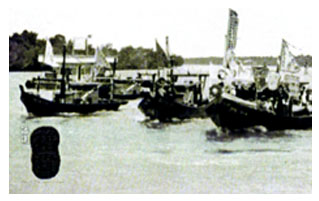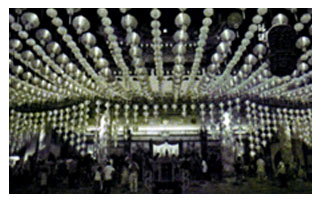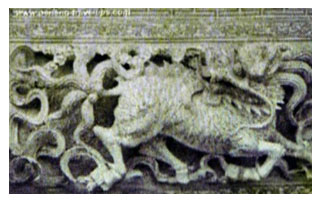





海南岛位于中国的最南端,自唐代开始,被称作"琼州",明代起被划入广东省,直到1988年才晋升为海南省。海南岛生活平静,物产丰富,所以海南人迟至19世纪中叶以后才大量出洋。海南人顺利抵达马来亚,安居乐业后,深感是受到神明的保佑,于是开始立庙侍奉,而海神是海南人重要的信仰之一。光绪十六年,海南人先在建立天后庙,供奉妈祖和水尾圣娘,并在每年农历三月二十三日庆祝妈祖神诞,溯流追源,带领更多人认识和承袭妈祖传统文化。
19世纪中叶以降,海南人开始大量出洋,抵达马来亚后,发现大部分行业已经被其他籍贯的华人所占,迟来的海南人只好到洋人家庭里当帮佣或成为海员。海南人长期接触西方饮食文化后,逐渐学会了烹调西餐的技巧,经济稳定后,开始投入餐饮业。经过多方的改良,海南人结合中西方的料理方式,形成风味独特的海南西餐,其中以海南鸡扒、法式土司、海南咖啡和海南面包最为人熟知。中西合并的海南西餐表现了海南人包容的民族特性,经过百年的发展,这些美食己变成海南人的传统文化,但海南人并不墨守成规,而是随着时代的变化,不断发挥勇于创新的精神,吸收其他族群的烹饪特色,以迎合新生代的口味,也为美食爱好者带来更多的口福和惊喜。
除了中西合并的料理技巧,海南人也未忘记原乡的烹调手法,其中以海南鸡饭最为人熟知。海南鸡饭源自海南四大名菜之首的"文昌鸡"。据说,文昌人用米糠和穀粒饲养土鸡,使鸡肉结实而有弹性,煮出来的白斩鸡也就特别皮滑肉嫩。海南人把这道传统海南美食带到马来亚后,保留了文昌人烹煮白斩鸡的特色,但为了配合本地人爱吃辣的习惯,又在原来用小桔子和蒜茸做成的佐料中加入辣椒,使海南鸡饭更具本地特色而成为华人喜爱的佳肴之一。
海南岛的居民依海而居,多以捕鱼为生,部分海南人南来时,就选择靠水吃水。海南先民在港口的对岸落脚后,建立了海南村,除了捕鱼,海南人也会到临近的岛捉螃蟹。为了祈求神明保佑平安和丰收,海南人在沼地之上建立昭应祠,供奉海南村的信众把昭应公供奉海南村的信众把昭应公、大伯公、每年的三月和九月,村内的爱群剧社也会表演传统的琼剧,向神明表达谢意。琼剧始于明代,1850年代随海南人传到马来亚。
Penang Thean Hou Temple
Shui Wei deity or Goddess of Water Margin
(Water Front)
Thean Hou deity, Ma Chor Po also
known as Mazu.

Exquisite stone carvings atHainan Temple
The Hainan Temple also known as THEAN HOU GONG or Temple of the Heavenly Queen is a Hainanese temple dedicated to the patron deity of seafarers, Ma Chor Po also known as Mazu. The temple was founded in 1866. The building was relocated to Muntri Street, Penang in 1895. The Hainan Temple is built in the Hainanese style, and is ornately embellished with exquisite stone carvings executed in the Sung dynasty style. The stonework that we see today is the work of craftsmen from China who were employed to remodel the temple in 1995,in conjunction with the centenary of its completion.
Although the exterior section has been newly renovated with stone sculpture wall in 1994-5, the interior ofThean Hou Temple pillars and beams, housed many historical relics and calligraphic carvings that date back to the Ching dynasty of China.
At the rear of the temple in the central section is placed the Thean Hou deity. On the right is the Shui Weideity or the Goddess of Water Margin, another Goddess of the Seas that originated from Hainan, China. On the left is the memorial plaque for 108 Hainanese martyrs who survived the stormy journey at sea only to be captured and wrongfully killed by the Vietnamese emperor in the 19th century. A cook survived the ordeal, however. Subsequently, the Vietnamese emperor realised his mistake and conferred them the honour of martyrship. They were subsequently honoured by Hainanese as deities protecting fishermen and sailors at seas.
In line with the Taoist-Buddhist-Confucianist tradition of the Chinese religious beliefs, the temple also houses other deities, among them Guan Ying, the Goddess of Mercy and Guan Gong, a historical figure of the Three Kingdom period of Chinese History.
The Kheng Chew Hoay Kuan was renamed Hainan Clan Association in 1991. This led to the setting up of a restoration committee that oversaw the restoration work on the Hainan Temple completed in 1995.
源起天后宫■缘聚益华学校 海南会馆历经逾148载

位于南华医院路的槟城海南会馆外观

海南会馆前身就是天后宫
海南古称琼州,行政上属广东所管辖,现已晋升为省,是中国第一大岛。 槟城海南会馆原名天后宫,宫址原在义兴街海记栈对面。早期到来槟城的海南人,成立琼州会馆之前,先建立《天后宫》供奉守护神。琼州人建立群体组织后,加入广汀会馆为属下乡会成员之一,并在1925年当年会长王谟仁力主下,将天后宫更名为琼州会馆。海南晋升为省后命名为海南会馆。 海南会馆旗下重要资产包括天后宫以及益华学校。
海南会馆创始年代,由于缺少史籍考证而难以确定。不过,惟证诸馆内木刻牌匾以《莫不尊亲》最为古老,是清同治九年,即公元1870年之文物,证明槟城海南会馆创立距今已有至少148年。
据乡贤老前辈口述所得,约于公元1866年前,同乡先辈航海南来,在槟岛落脚。为祈求平安,乡贤守望相助,在槟城义兴街海记栈对面,租屋设馆供奉天后圣母(婆祖)及108兄弟公等神祗,馆宇因陋就简,经费仅靠香油捐来维持。 公元1895年,周衡山、王锡福、杨成茂、冯尔志、周飞钊、朱仁育、曹俊琪、 林英文、邢泉清诸先贤等,将义兴街庙址售出,并发起捐款,购买地皮,在南华医院街九十三号兴建海南会馆永久基业。
益华学校创办于1913年,当时仅设夜校,校址在南华医院街。发起人为曾任《光华日报》编辑李永辉及郑一书、朱仁育、朱益三等。首任校长为《光华曰 报》主笔杨因冰。益华学校在1915年开办日校,却在翌年停办。直到1919 年,庄春华及庄家钵目睹失学儿童日增,才获得复办。
当时益华学校校舍在琼州会馆走廊内,校长为韩晓山。1920年,林英文任当年琼洲会馆总理时,为宣扬文化,作育英才以及方便同乡子女上学,正式接办益华学校。
天后宫主要祭拜海员的保护神“妈祖",在“妈祖诞”的日子里,信徒还会杀羊膜拜并且大事庆祝一番,场面十分热闹。1995年琼州会馆一百周年时,该寺庙特别从中国邀请雕刻师父,重修和设计寺庙龙雕塑像。整座寺庙在当年经过了一次的完整大翻修。
PENANG HAINAN ASSOCIATION
Around 1866, the Hainanese community in Penang established a temple and dedicated it to the Sea Goddess, Mazu,妈祖. This temple, known as "Thean Hou Keong”,天后宫(Temple of the Heavenly Queen), fulfilled religious needs of the Hainan community and served as a social centre. About thirty years later in 1895,the temple was relocated to Muntri Street, where it continues to stand today.The land and construction cost for the new temples was raised through public donations. The new temple continued to serve religious and social needs of the Hainan community.
In 1925,the temple became a clan association through a name change from "Temple of the Heavenly Queen” to "Penang Kheng Chew Association", 槟城琼州会馆. The clan association continued to function till the fall of Penang to the Japanese in 1941 and was only able to resume activity in 1945 after the end of World War Two.In the post war period, the clan association established hospitals, scholarship funds, schools and economic development projects to serve their community. The clan association also worked with other Chinese groups to establish the Penang Chinese Conference Hall located next to the oldest temple in Penang, the Kong Hock Keong,广福宫 also know as the Guan Yin temple.
In 1991,the association was renamed as Penang Hainan Association,海南会馆,embracing a wider ethnic identity. By this time, the temple was almost a hundred years old and had weathered world wars and major social change.
To celebrate this historical milestone, a committee was formed to oversee a major restoration of the temple. Expert craftsmen were from China were invited to participate in the restoration work. The project was completed in 1997 and the restored temple is decorated with stone carvings depicting stories of Mazu and popular legends.
The central shrine is dedicated to Mazu, the sea goddess, and to her left is a shrine dedicated to Goddess of the Waterfront 水尾娘娘,a deity from Hainan Island in China. The right shrine is dedicated to 108 brothers.
Entrance of Penang Hainan Association
Altar to Mazu at Hainan Temple

Stone sculpture of Mazu saving seafarers
Front facade of Hainan Temple